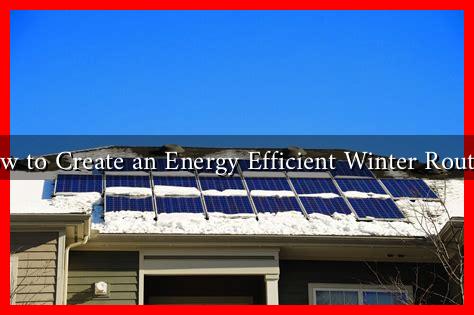-
Table of Contents
How to Create an Energy Efficient Winter Routine
As winter approaches, the need for energy efficiency becomes increasingly important. With colder temperatures, heating costs can skyrocket, leading to higher energy bills and a larger carbon footprint. However, by adopting an energy-efficient winter routine, you can save money, reduce energy consumption, and contribute to a more sustainable environment. This article will explore practical strategies to create an energy-efficient winter routine.
Understanding Energy Consumption in Winter
During winter, households typically see a significant increase in energy usage due to heating needs. According to the U.S. Energy Information Administration (EIA), space heating accounts for about 42% of residential energy consumption in the winter months. Understanding this statistic is crucial for identifying areas where you can improve efficiency.
1. Optimize Your Heating System
Your heating system is the most significant contributor to your winter energy consumption. Here are some ways to optimize it:
- Regular Maintenance: Schedule annual maintenance for your furnace or boiler to ensure it operates efficiently. A well-maintained system can operate up to 15% more efficiently.
- Programmable Thermostats: Install a programmable thermostat to automatically lower the temperature when you’re not home. This can save you up to 10% on heating costs.
- Seal Ducts: Leaky ducts can waste a significant amount of heated air. Sealing and insulating ducts can improve your system’s efficiency by as much as 20%.
2. Insulate Your Home
Proper insulation is key to maintaining a comfortable temperature without over-relying on heating systems. Consider the following:
- Attic Insulation: Insulating your attic can prevent heat loss, which is responsible for 25% of heating costs. Aim for an R-value of 38 or higher, depending on your climate.
- Weatherstripping: Apply weatherstripping around doors and windows to eliminate drafts. This simple fix can save you up to 15% on heating bills.
- Use Thermal Curtains: Invest in thermal curtains to keep the cold out and the heat in. They can reduce heat loss by up to 25%.
3. Embrace Natural Heat Sources
Utilizing natural heat sources can significantly reduce your reliance on artificial heating. Here are some tips:
- Open Curtains During the Day: Let sunlight in during the day to naturally warm your home. Close them at night to retain heat.
- Use Space Heaters Wisely: If you spend most of your time in one room, consider using a space heater instead of heating the entire house. Ensure it is energy-efficient and has safety features.
- Cook Wisely: Use your oven to cook meals, as it generates heat that can warm your kitchen and adjacent rooms.
4. Reduce Hot Water Usage
Water heating is another significant energy consumer in winter. Here are ways to reduce hot water usage:
- Lower Water Heater Temperature: Set your water heater to 120°F (49°C) to save energy and prevent scalding.
- Install Low-Flow Fixtures: Use low-flow showerheads and faucets to reduce hot water consumption without sacrificing performance.
- Take Shorter Showers: Reducing shower time by just a few minutes can save gallons of hot water daily.
5. Monitor Your Energy Usage
Keeping track of your energy consumption can help you identify areas for improvement. Consider these tools:
- Smart Meters: Install a smart meter to monitor real-time energy usage and identify peak consumption times.
- Energy Audits: Conduct a home energy audit to pinpoint inefficiencies. Many utility companies offer free audits or incentives for energy-efficient upgrades.
Conclusion
Creating an energy-efficient winter routine is not only beneficial for your wallet but also for the environment. By optimizing your heating system, improving insulation, utilizing natural heat sources, reducing hot water usage, and monitoring your energy consumption, you can significantly decrease your energy bills and carbon footprint. As we face the challenges of climate change, every small step counts. Start implementing these strategies today and enjoy a warmer, more sustainable winter.
For more information on energy efficiency, visit the U.S. Department of Energy’s Energy Saver website.

